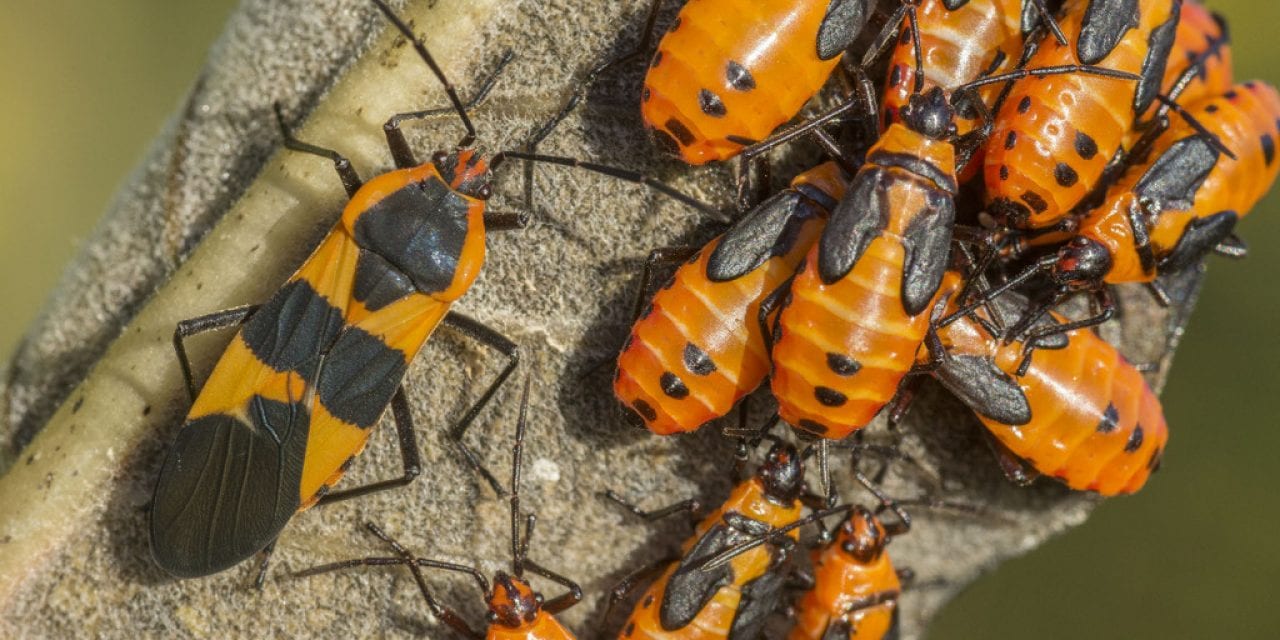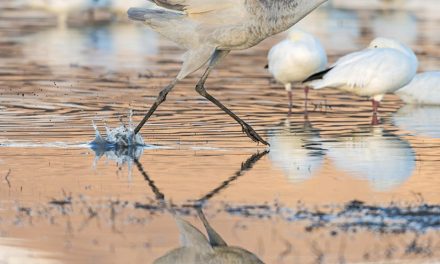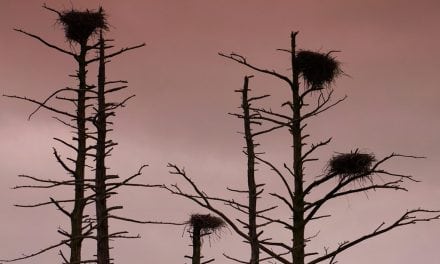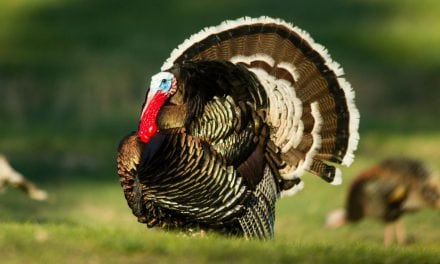Enlarge
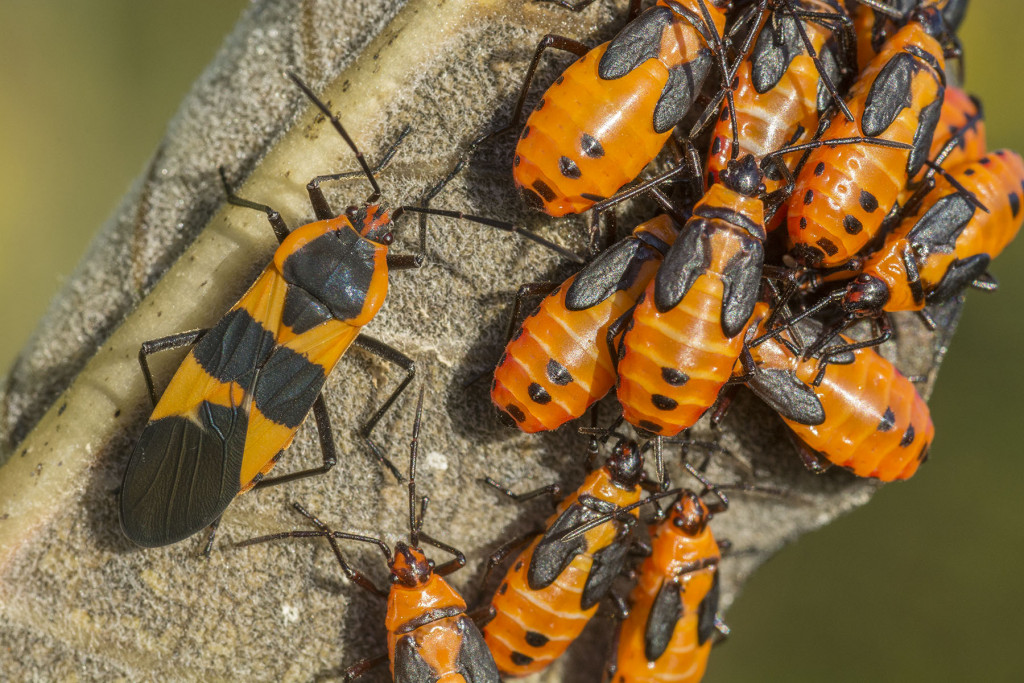
Story and photos by Chris Helzer
If you pay attention to milkweed plants during the summer, you’ll notice a wide variety of insect species feeding on the nectar produced by milkweed flowers. That nectar is sweet, nutritious and free of the toxic latex found throughout most of the rest of the plant. A much smaller group of insects can be found feeding on the leaves, stems or seeds of those milkweed plants, both dealing with and taking advantage of the toxicity. Those insects include monarch caterpillars, milkweed tussock caterpillars, oleander aphids, longhorned milkweed beetles and both large and small milkweed bugs.
All of those insects have compelling natural history stories, but this article focuses on the large milkweed bug, an insect that is commonly seen, but often misidentified. The uncreatively-named ‘large milkweed bug’ (Oncopletus fasciatus) is different from two species of ‘small milkweed bugs’ (Lygaeus sp), and those are different from boxelder bugs (Boisea trivittata). It’s easy to confuse them with each other, speaking from personal experience, but a few simple visual cues can help you tell them apart.

First, boxelder bugs are much more black than orange when viewed from the top. The orange is mostly an accent color on an otherwise black back. In comparison, both the large milkweed bug and the various species of small milkweed bugs have considerable orange coloration. The large milkweed bug has a longer, more slender body shape and a solid black band across the middle of its back. That contrasts with the black hourglass shape and solid orange ‘X’ on the back of small milkweed bugs. Got it? This article focuses on the large milkweed bug — the one with the slender body and a black band across the back.
Large milkweed bugs are specialist herbivores on milkweed plants, especially common milkweed (Asclepias syriaca). Milkweed plants produce latex, which is the white sticky substance you see when you break off a leaf. That latex is toxic to most creatures, but some invertebrates have developed techniques to deal with that toxicity and use it to their advantage. In the case of large milkweed bugs, the toxic chemicals (cardenolides) are stored inside specialized compartments and can be released when the insects are threatened.
The strong orange and black coloration of the large milkweed bug is similar to that of other invertebrates that feed on toxic plants and use that toxicity as a defense mechanism. Monarch butterflies, of course, are in the same category, along with ladybugs and the smaller milkweed bugs mentioned above. Large milkweed bugs pass their toxicity along to their eggs, which are also orange-colored and, apparently, taste really bad.
Both adult and juvenile large milkweed bugs feed mainly on the seeds of milkweed, which fuel strong growth and reproduction. They will sometimes eat other parts of the milkweed plant — stems, buds or flowers — but they fare much less well on that diet. Adult large milkweed bugs will branch out and feed on nectar from various kinds of flowers. They also have been observed eating monarch eggs, aphids and even others of their own kind, but it’s not clear whether this is out of desperation or a common occurrence.
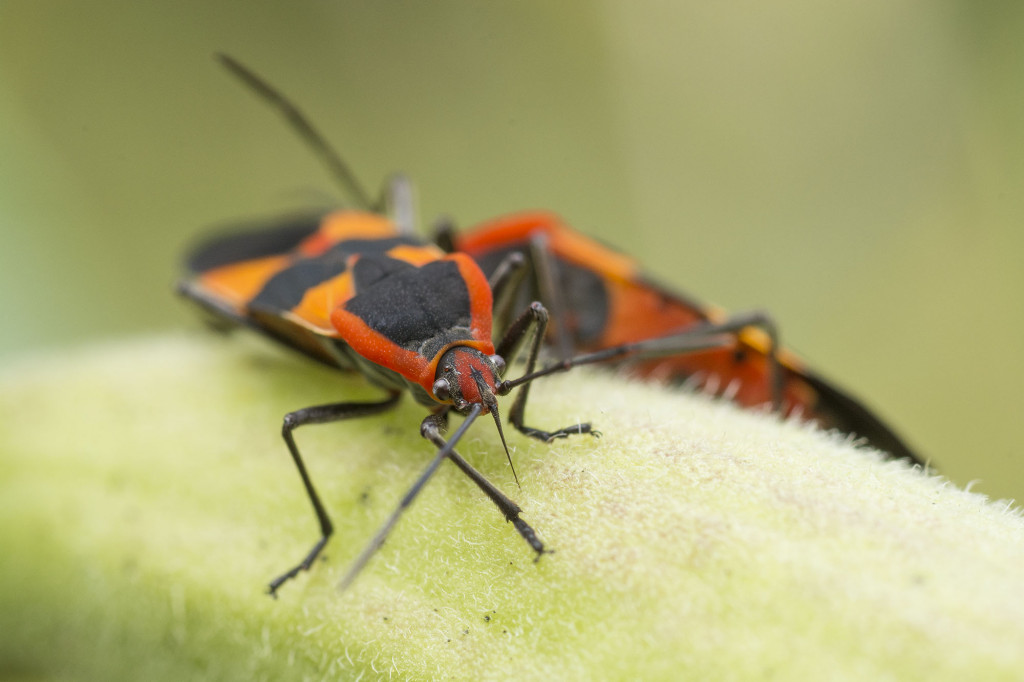
Like other “true bugs” in the order Hemiptera, large milkweed bugs feed through a straw-like mouthpart called a rostrum. Milkweed bugs insert that rostrum into seeds and inject their saliva into the seed, which basically pre-digests it. They then suck up and consume the liquefied contents of that pre-digested seed.
Large milkweed bugs lay eggs in or on seed pods. When those eggs hatch, the young bugs, called nymphs, have a similar orange and black pattern, but without full-sized wings. Those nymphs grow and molt four times before becoming adults, a process that takes roughly a month. Adults can’t survive cold winters, so many of them migrate to the south in the fall. A new batch of milkweed bugs then migrates back to Nebraska the following summer.
After hatching, nymphs of large milkweed bugs tend to hang out in gangs on milkweed pods. If the pods are open, they will feed directly from the seeds. However, when the pods are closed, they may or may not be able to poke through the pod and into the seeds within. As they grow larger and more mature, their rostrum lengthens and they’re better able to reach seeds inside closed pods.
During a period when efforts are aimed at increasing population sizes of milkweeds, especially for monarch butterfly conservation, it may seem odd to celebrate an insect that helps destroy its seeds. However, it’s not the large milkweed bug’s fault that milkweed numbers have declined. Milkweed and the various insects that rely upon it for food have coexisted for many thousands of years. Many of those insects have used the toxicity of milkweed latex as a defense mechanism, and they enjoy the benefits of their ability to eat a plant most other insects eschew, not chew.
Plus, how can you not celebrate the large milkweed bug? It injects its spit into seeds to predigest them, uses poison as a weapon and migrates long distances — especially for such a small insect. The next time you see a mass of orange bugs on a milkweed pod, don’t dismiss them as boxelder bugs (which have their own fascinating story, by the way). Instead, pause a moment and admire the bug’s bold coloration and watch it suck the predigested juice out of a milkweed seed. Or, just admire its color. ■
Chris Helzer is the Nature Conservancy’s director of science in Nebraska.
The post Large Milkweed Bugs appeared first on Nebraskaland Magazine.

